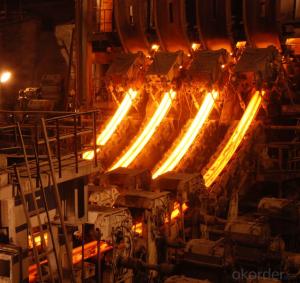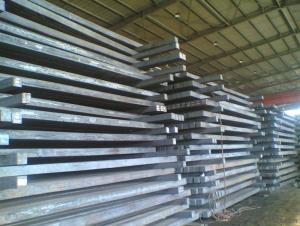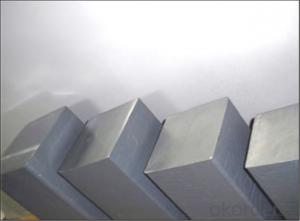Square Steel Billet Q235 3SP Grade Prime Quality 9#
- Loading Port:
- Tianjin
- Payment Terms:
- TT OR LC
- Min Order Qty:
- 2000 m.t
- Supply Capability:
- 50000 m.t/month
OKorder Service Pledge
OKorder Financial Service
You Might Also Like
Description of Square Steel Billet Q235 3SP Grade Prime Quality 9#
M. S. Billets are used for rolling of TMT Re-Bars of Fe415 and Fe500 Grade and various other structural steel products.
CRS Billets are used for rolling of CRS TMT Re-Bars.
Special Alloy Billets are used for rolling of any special grade TMT Re-Bars like Earthquake resistant TMT Re-Bars and for special grade structural steel products.
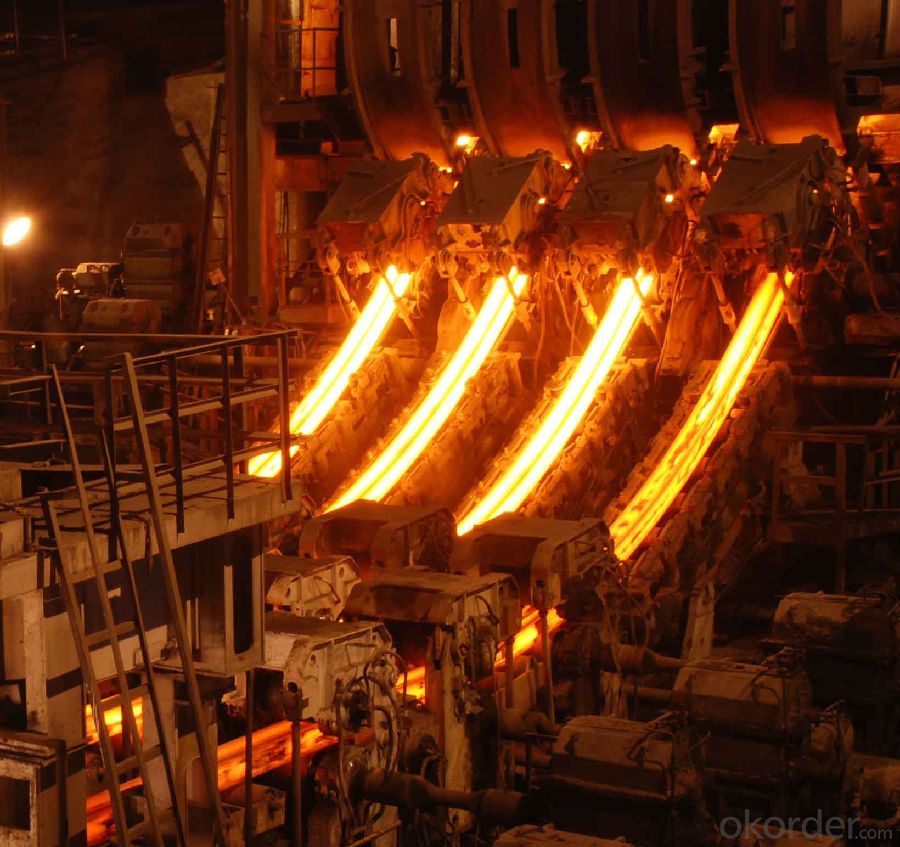
Main Feature Square Steel Billet Q235 3SP Grade Prime Quality 9#
Raw elements(C,Fe,Ni,Mn,Cr,Cu.)---Smelted ingots by AOD finery---hot rolled into black suface---pickling in acid liquid---cold drawn----polished by automatically machine--- cutting into pieces---checking quanlity
Applications of Square Steel Billet Q235 3SP Grade Prime Quality 9#
Widely Used in the areas such as Stainless Steel Fasteners, Chains, Kitchen and Sanitary wares, Furniture handles, Handrails, Electroplating and Electrolyzing pendants, Foods, Electron, Petroleum, Construction and Decoration, etc. Products have a high strength after cold-working. Electronic products parts, Medical appliance, Springs, Bus Inside and Outside packaging and building, Street Lamp Posts, etc. Decoration materials and Outdoor Publicity Billboard. Used for the products which have the Anti-Stress Corrosion requirement. Electron Products, Table-wares, Bolts, Nuts, Screen Meshes, Cumbustors and so on.
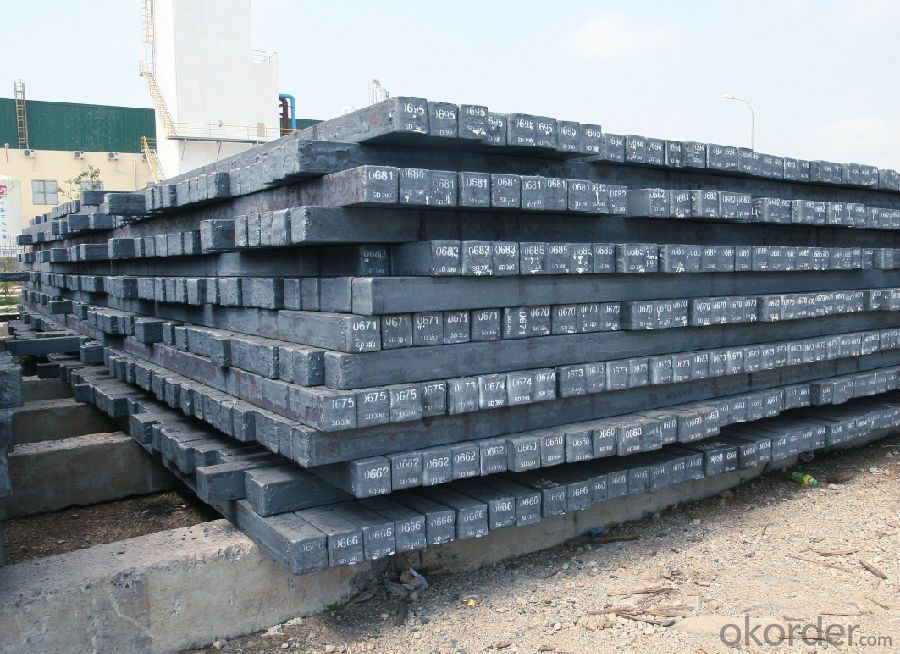
Specifications of Square Steel Billet Q235 3SP Grade Prime Quality 9#
| Standard | C(%) | Mn(%) | S(%) | P(%) | Si(%) |
| Q195 | ≤0.12 | ≤0.50 | ≤0.040 | ≤0.035 | ≤0.30 |
| Q235 | ≤0.20 | ≤1.40 | ≤0.045 | ≤0.045 | ≤0.35 |
| Q275 | ≤0.22 | ≤1.50 | ≤0.045 | ≤0.045 | ≤0.35 |
| 20MnSi | 0.17-0.25 | 1.2-1.6 | ≤ 0.050 | ≤ 0.050 | 0.40-0.80 |
| 3SP | 0.14-0.22 | 0.40-0.85 | ≤ 0.050 | ≤ 0.040 | 0.05-0.15 |
| 5SP | 0.28-0.37 | 0.50-1.00 | ≤ 0.050 | ≤ 0.040 | 0.15-0.30 |
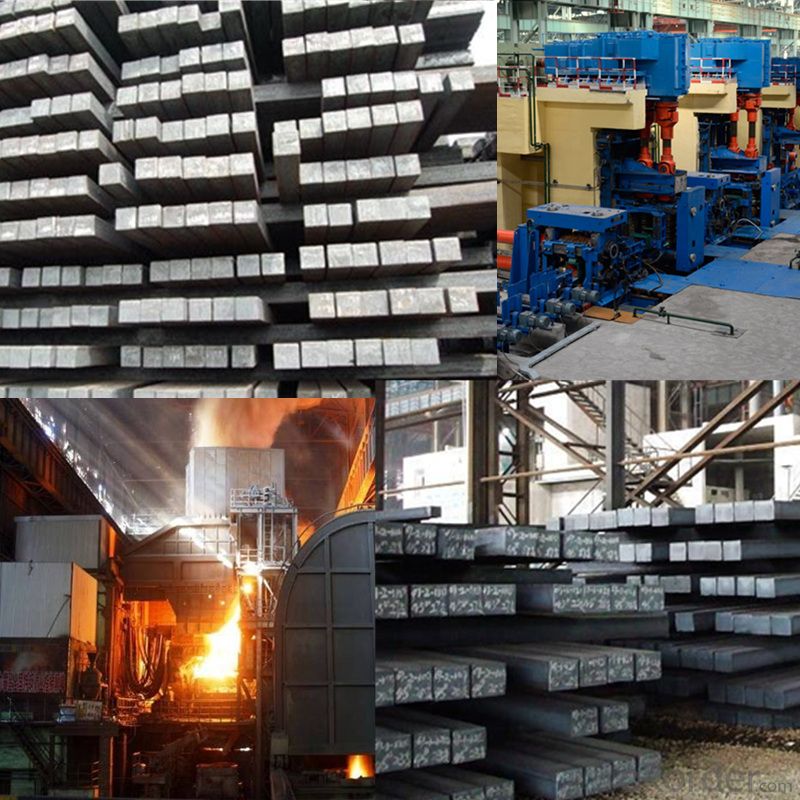
FAQ of Square Steel Billet Q235 3SP Grade Prime Quality 9#
We have organized several common questions for our clients,may help you sincerely:
1. How Can I Visit There?
Our company is located in Tianjin City, China, near Beijing. You can fly to Tianjin Airport Directly. All our clients, from home or aboard, are warmly welcome to visit us!
2. How Can I Get Some Sample?
We are honored to offer you sample.
3. Why choose CNBM?
Our delivery time about 15-20days for standard sizes, if you have other requirements like hardness, quanity and width ,it is about 20-40days. But don't worry we also try our best for the delivery time ,because time longer and our cost is higher.
- Q:What industries use steel billets?
- Several industries use steel billets, including automotive, construction, manufacturing, and infrastructure. Steel billets are commonly used as raw material in the production of various metal products such as pipes, rods, bars, wires, and sheets. They are also utilized in the construction of bridges, buildings, and other structural components. The automotive industry uses steel billets for manufacturing parts like engine blocks, chassis, and suspension components. Additionally, steel billets find applications in the energy sector, machinery production, and shipbuilding.
- Q:What is the role of steel billets in the construction of airports and terminals?
- Steel billets are essential in the construction of airports and terminals due to their advantageous properties. Essentially, they are semi-finished metal products used as raw materials for manufacturing various steel products. When it comes to airports and terminals, steel billets are mainly used to produce structural steel components like beams, columns, and trusses. The strength and durability of steel billets make them preferred in the construction industry. Steel is well-known for its high tensile strength, enabling it to withstand heavy loads and structural stresses. This makes it ideal for building large and complex structures such as airports and terminals, where safety and reliability are paramount. Moreover, steel billets can be easily shaped and sized to construct different components needed in airports and terminals. These billets are often hot rolled or forged into the desired shapes, ensuring the resulting steel products have the necessary strength and structural integrity. Another advantage of using steel billets in airport and terminal construction is their resistance to adverse environmental conditions. Airports and terminals face harsh weather conditions, including extreme temperatures, moisture, and corrosion. Steel, especially when properly coated or treated, is highly resistant to these factors, ensuring the longevity and structural stability of the facilities. Furthermore, steel billets are relatively cost-effective compared to other construction materials, especially considering their durability and low maintenance requirements. The long lifespan of steel structures reduces the need for frequent repairs or replacements, resulting in cost savings over time. In conclusion, steel billets are crucial in constructing airports and terminals as they provide the required strength, durability, and versatility for large-scale structures. Their ability to withstand heavy loads, resistance to environmental factors, and cost-effectiveness make them an ideal choice for these high-demand facilities.
- Q:What are the properties and characteristics of steel billets?
- Steel billets, typically utilized in the production of various steel products, exhibit numerous properties and characteristics that render them suitable for such applications. To begin with, their exceptional strength-to-weight ratio endows steel billets with immense strength, enabling them to withstand heavy loads. This strength is derived from the steel's carbon content, which enhances its structural integrity. Furthermore, their superb heat conductivity facilitates efficient heat transfer during diverse manufacturing processes. Consequently, steel billets prove ideal for applications involving high-temperature operations, such as forging and rolling. Moreover, their remarkable machinability enables easy shaping and forming into desired products. This property is of utmost importance in the manufacturing industry, as it allows for the production of intricate and personalized steel components. Steel billets also possess outstanding ductility, enabling them to stretch and mold without fracturing. This characteristic proves vital in applications requiring bending or forming the steel into various shapes. In addition, steel billets exhibit a high resistance to corrosion, rendering them suitable for outdoor or corrosive environments. This property guarantees the durability and longevity of steel products manufactured from billets. Furthermore, steel billets can be effortlessly welded, facilitating the fabrication of large and intricate structures. Their weldability renders them versatile and adaptable to diverse construction and manufacturing needs. Lastly, steel billets boast a consistent and uniform composition, ensuring the production of high-quality and dependable steel products. This consistency is achieved through meticulous manufacturing processes and rigorous quality control measures. To conclude, steel billets possess numerous properties and characteristics that make them highly sought-after in the production of steel products. Their high strength, heat conductivity, machinability, ductility, corrosion resistance, weldability, and consistent composition deem them indispensable in various industries, including construction, automotive, and manufacturing.
- Q:What is the global production and consumption of steel billets?
- The global production and consumption of steel billets vary each year based on market demand and economic factors. However, steel billets are a crucial raw material in the steel industry, used for further processing into various steel products. The production and consumption of steel billets are significant in countries with a robust steel industry, such as China, India, the United States, and Russia. Accurate figures for global production and consumption can be obtained from industry reports and statistical data provided by organizations like the World Steel Association.
- Q:How do steel billets contribute to the manufacturing of telecommunications equipment?
- Steel billets play a crucial role in the manufacturing of telecommunications equipment by providing the necessary raw material for various components and structures. These billets, typically made from carbon steel, are semi-finished products that are further processed to create specific shapes and sizes required for telecommunications equipment. One of the key ways steel billets contribute to the manufacturing of telecommunications equipment is by serving as the base material for the fabrication of towers and masts. These structures are vital for the installation of antennas and satellite dishes, enabling the transmission and reception of signals for telecommunications networks. Steel billets are shaped and welded to create sturdy and durable towers that can withstand various environmental conditions. Moreover, steel billets are also used in the production of enclosures and cabinets for housing telecommunication equipment. These enclosures provide protection from external factors such as dust, moisture, and vandalism, ensuring the proper functioning and longevity of the equipment. Steel billets are formed into panels, frames, and chassis that are then assembled to create robust enclosures that can withstand harsh environments. In addition, steel billets contribute to the manufacturing of telecommunications equipment by being used in the production of cable trays and supports. These components are essential for organizing and routing cables, providing a neat and efficient infrastructure for telecommunications systems. Steel billets are rolled and formed into various shapes, such as channels and angles, to create sturdy cable trays and supports that can handle the weight and stress of multiple cables. Furthermore, steel billets are also utilized in the fabrication of connectors and brackets for telecommunications equipment. These small yet crucial components provide the necessary connections and support for different devices and modules in telecommunications systems. Steel billets are machined, drilled, and shaped into specific designs to create reliable connectors and brackets that ensure proper functionality and stability. Overall, steel billets play a vital role in the manufacturing of telecommunications equipment by providing the necessary raw material for various components and structures. Their strength, durability, and versatility make them an ideal choice for creating robust and reliable equipment that can withstand the demands of modern communication networks.
- Q:What is the average weight of a steel billet?
- The average weight of a steel billet can vary depending on its size and dimensions. However, a typical steel billet can weigh anywhere between 1,000 kilograms (2,204 pounds) to 5,000 kilograms (11,023 pounds). These weights are typical for industrial-grade steel billets used in various manufacturing processes such as forging, rolling, and extrusion. It's important to note that the weight of a steel billet can also be customized based on specific requirements and industry standards.
- Q:How are steel billets used in the production of building facades?
- Due to their versatility and strength, steel billets are a vital component in the manufacturing of building facades. Building facades, which serve as both an aesthetic feature and a protective barrier against external elements, rely on steel billets for various purposes. To begin with, steel billets, which are semi-finished steel products, are commonly used as the primary material for the structural framework of facades. Their high strength-to-weight ratio makes them an ideal choice for supporting the weight of the facade and ensuring structural stability for the building. Furthermore, steel billets can be further processed to create different shapes and profiles required for facade design. Through processes like hot rolling, cold rolling, or extrusion, architects and designers can shape steel billets into intricate and customized designs. This flexibility allows for the creation of unique and aesthetically pleasing facades that enhance the overall appearance of the building. Steel billets also find application in the production of curtain wall systems, which are commonly used in modern building facades. Acting as non-structural cladding systems, curtain walls are attached to the building's structural framework. Steel billets are frequently utilized in the creation of curtain wall support systems, providing the necessary strength and durability to withstand external pressures such as wind loads and seismic forces. Additionally, steel billets can be coated or treated with various finishes to enhance their corrosion resistance and increase their longevity. From galvanization to powder coating, these finishes ensure that the building facade remains durable and visually appealing over time. In conclusion, steel billets play a critical role in the manufacturing of building facades, offering strength, design flexibility, and durability. Their utilization in the structural framework, creation of customized shapes, support systems for curtain walls, and application of protective finishes make them an indispensable material in the construction industry.
- Q:How are steel billets used in the manufacturing of shipbuilding parts?
- Steel billets play a crucial role in the manufacturing of shipbuilding parts. These billets are essentially semi-finished steel products, typically in the form of rectangular or square bars, that are used as raw material for further processing in shipbuilding. To begin with, steel billets are subjected to a process called rolling, where they are passed through a series of rollers to reduce their cross-sectional area and increase their length. This rolling process transforms the billets into long, thin sections of steel known as plates or sheets. These plates or sheets are then used to create various shipbuilding components, such as hulls, decks, bulkheads, and superstructures. After the rolling process, the steel plates or sheets are cut into desired sizes and shapes using cutting machines or torches. These cut pieces are then formed, bent, and welded together to form the required shipbuilding parts. For instance, the steel plates may be bent and welded to create curved sections for the ship's hull, or they may be formed into intricate shapes for other components. Moreover, steel billets are also used to produce forged shipbuilding parts. In this case, the billets are heated to a high temperature and then subjected to intense pressure to reshape the steel. This forging process results in stronger and more durable shipbuilding parts, which are often used for critical components like propeller shafts, crankshafts, and turbine blades. In summary, steel billets serve as the starting point in the manufacturing of shipbuilding parts. Through processes like rolling, cutting, forming, and forging, these billets are transformed into plates, sheets, and forged components that are used to construct the various structural and functional elements of ships.
- Q:What are the common surface defects in steel billets during cooling?
- Common surface defects in steel billets during cooling include cracks, surface scaling or oxidation, and surface decarburization.
- Q:What is the shelf life of a steel billet?
- The durability of a steel billet can vary based on various factors. In order to prevent corrosion and uphold their quality, steel billets are typically stored in controlled environments. With proper storage, steel billets can remain usable for several years. However, it is essential to acknowledge that the shelf life can be influenced by factors such as humidity levels, exposure to moisture or chemicals, and the specific type of steel employed. Consequently, it is crucial to adhere to the storage guidelines provided by manufacturers to guarantee an extended shelf life for steel billets. Regular inspections and maintenance can also aid in identifying any potential issues that may impact the durability of the billets.
1. Manufacturer Overview |
|
|---|---|
| Location | |
| Year Established | |
| Annual Output Value | |
| Main Markets | |
| Company Certifications | |
2. Manufacturer Certificates |
|
|---|---|
| a) Certification Name | |
| Range | |
| Reference | |
| Validity Period | |
3. Manufacturer Capability |
|
|---|---|
| a)Trade Capacity | |
| Nearest Port | |
| Export Percentage | |
| No.of Employees in Trade Department | |
| Language Spoken: | |
| b)Factory Information | |
| Factory Size: | |
| No. of Production Lines | |
| Contract Manufacturing | |
| Product Price Range | |
Send your message to us
Square Steel Billet Q235 3SP Grade Prime Quality 9#
- Loading Port:
- Tianjin
- Payment Terms:
- TT OR LC
- Min Order Qty:
- 2000 m.t
- Supply Capability:
- 50000 m.t/month
OKorder Service Pledge
OKorder Financial Service
Similar products
New products
Hot products
Hot Searches
Related keywords
